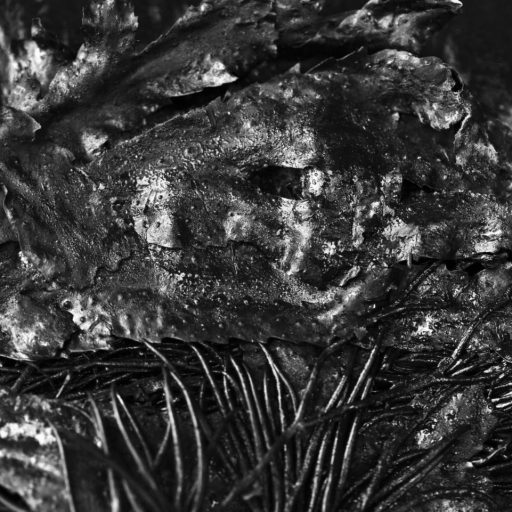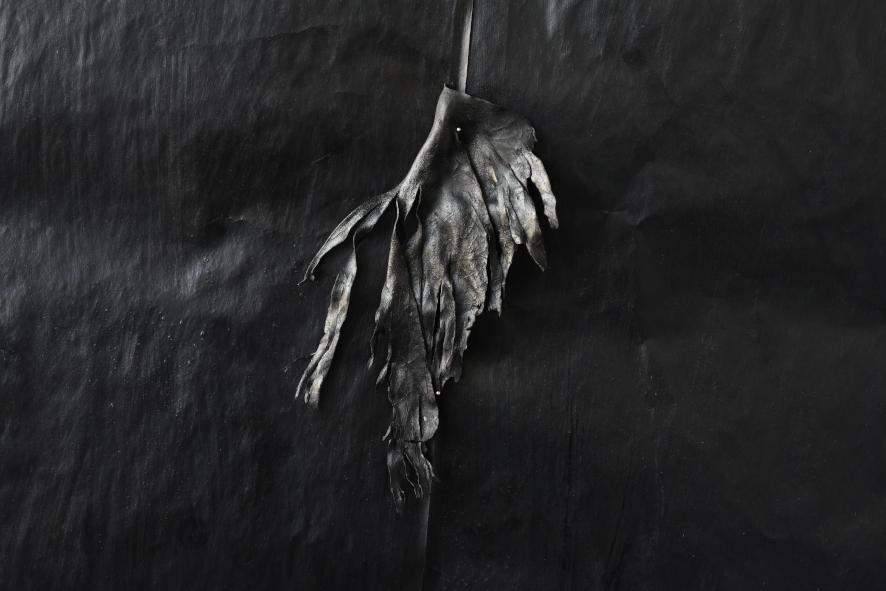J’ai créé une nouvelle installation récurrente à l’occasion de l’exposition au 102-Ter à Caen en avril 2023 que j’appelle “Noir et bas-reliefs”. L’idée est venue progressivement en écho à mes “forêts”, comme une sorte de contrepoint symétrique et complémentaire, le noir et le blanc, le yin et le yang…
I’ve created a new recurring installation to coincide with the exhibition at 102-Ter in Caen in April 2023, which I call ‘Black and bas-reliefs’. The idea came gradually as an echo to my ‘forests’, as a kind of symmetrical and complementary counterpoint, black and white, yin and yang…
Ho creato una nuova installazione ricorrente in concomitanza con la mostra alla 102-Ter di Caen nell’aprile 2023, che ho chiamato “Nero e bassorilievi”. L’idea è nata gradualmente come eco delle mie “foreste”, come una sorta di contrappunto simmetrico e complementare, bianco e nero, yin e yang…

Détail du mur noir / detail of the black wall / dettaglio della parete nera – Coutances (2024)
Depuis longtemps déjà j’explore comment le noir capte la lumière pour mieux nous la révéler au travers du prisme du relief. Il joue quasiment le rôle de révélateur, au sens photographique du terme, dans un aller-retour étonnant. Le procédé photographique argentique permettait de capturer la lumière en empêchant les sels d’argent de noircir par inversion de l’image capturée, via le négatif. Ici c’est le relief, voire le bas-relief, dans le noir absolu, qui capture la lumière. Il devient localement blanc, avec la capacité étonnante d’intégrer l’angle de vision du spectateur dans cette révélation qui s’avère changeante. Le spectateur devient acteur de la révélation de la lumière par le noir, ouvrant des perspectives formidables pour des installations.
For a long time now, I’ve been exploring how black captures light to better reveal it to us through the prism of relief. It almost plays the role of a developer, in the photographic sense of the word, in an astonishing back-and-forth process. The silver photographic process captures light by preventing the silver salts from darkening, by inverting the captured image via the negative. Here it is the relief, or even the bas-relief, in absolute black, that captures the light. It becomes locally white, with the astonishing ability to incorporate the viewer’s angle of vision into this changing revelation. The viewer becomes an actor in the revelation of light through black, opening up tremendous possibilities for installations.
Da tempo esploro il modo in cui il nero cattura la luce per rivelarla meglio attraverso il prisma del rilievo. Svolge quasi il ruolo di uno sviluppatore, nel senso fotografico del termine, in uno stupefacente processo di retroazione. Il processo fotografico all’argento cattura la luce impedendo ai sali d’argento di scurirsi, invertendo l’immagine catturata attraverso il negativo. Qui è il rilievo, o addirittura il bassorilievo, in nero assoluto, a catturare la luce. Diventa localmente bianco, con la sorprendente capacità di incorporare l’angolo di visione dello spettatore in questa rivelazione mutevole. Lo spettatore diventa un attore nella rivelazione della luce attraverso il nero, aprendo enormi possibilità per le installazioni.

Cette propriété étonnante décuple les propositions qui permettent d’ouvrir le champ de manoeuvre du spectateur dans son implication dans l’existence d’une oeuvre. C’est l’une des raisons principales qui m’a conduit à faire de grandes installations, au moins à l’échelle du spectateur, afin qu’il puisse y jouer son rôle pleinement. C’est une métaphore “réelle” et tangible de l’idée selon laquelle l’oeuvre est déterminée aussi par ceux qui la regardent.
This astonishing property increases tenfold the proposals that open up the spectator’s field of manoeuvre in his involvement in the existence of a work. This is one of the main reasons why I have chosen to make large installations, at least on the scale of the viewer, so that he or she can play a full part in them. It’s a ‘real’ and tangible metaphor for the idea that the work is also determined by those who look at it.
Questa sorprendente proprietà decuplica le proposte che aprono il campo di manovra dello spettatore nel suo coinvolgimento nell’esistenza di un’opera. Questo è uno dei motivi principali per cui ho scelto di realizzare installazioni di grandi dimensioni, almeno a misura di spettatore, in modo che possa parteciparvi pienamente. È una metafora “reale” e tangibile dell’idea che l’opera è determinata anche da chi la guarda.

Cette propriété est déjà visible à petite échelle, tout en limitant le rôle du spectateur. C’est le cas de l’assiette d’encrage, de l’algue complètement imbibée d’encre dans le pot et de celle déposée sur un bas-relief, mais aussi d’un détail de papier kraft froissé ou de papier washi.
This property is already visible on a small scale, while limiting the role of the viewer. This is the case with the inking plate, the seaweed completely soaked in ink in the pot and the seaweed placed on a bas-relief, as well as a detail of crumpled kraft paper or washi paper.
Questa proprietà è già visibile su piccola scala, pur limitando il ruolo dello spettatore. È il caso della lastra per l’inchiostrazione, dell’alga completamente imbevuta di inchiostro nel vaso e dell’alga posta su un bassorilievo, nonché di un dettaglio di carta kraft o carta washi accartocciata.



Eglise Saint-Nicolas – Coutances (2024)
Je poursuis l’idée du mur noir (yin), apparue en 2023 où les bas-reliefs construisent un ensemble unique, singulier, qui se niche dans le bâtiment, et qui offre au spectateur la possibilité de jouer avec la lumière.
I’m continuing the idea of the black wall (yin), which appeared in 2023, where the bas-reliefs create a unique, singular whole that nestles in the building, offering the viewer the chance to play with the light.
Prosegue l’idea del muro nero (yin), apparso nel 2023, dove i bassorilievi creano un insieme unico e singolare che si annida nell’edificio, offrendo allo spettatore la possibilità di giocare con la luce.




102 Ter – Caen (2023)
L’exposition au 102 Ter, bd Leroy à Caen, était l’acte I d’une proposition en deux temps, dont l’acte II a eu lieu à Cancan galerie à Villedieu-les-Poêles (50), intitulée Kaiso-e, ou peindre avec l’algue. En contrepoint à une forêt “sous-marine” qui était installée dans l’exposition, un mur d’encre noire (4.5 x 4.5 m) proposait une lecture des bas-reliefs et des algues, utilisées dans les travaux exposés, grâce à une lumière rasante provenant de l’immense baie vitrée orientée au nord.
The exhibition at 102 Ter, bd Leroy in Caen was Act I of a two-part project, Act II of which took place at Cancan galerie in Villedieu-les-Poêles (50), entitled Kaiso-e, or painting with seaweed. As a counterpoint to an ‘underwater’ forest installed in the exhibition, a wall of black ink (4.5 x 4.5 m) offered a reading of the bas-reliefs and seaweed used in the works on display, thanks to the low-angled light coming from the huge north-facing bay window.
La mostra al 102 Ter, bd Leroy di Caen è stata il primo atto di un progetto in due parti, il cui secondo atto si è svolto alla Cancan galerie di Villedieu-les-Poêles (50), intitolato Kaiso-e, ovvero dipingere con le alghe. Come contrappunto a una foresta “subacquea” installata nella mostra, una parete di inchiostro nero (4,5 x 4,5 m) ha offerto una lettura dei bassorilievi e delle alghe utilizzate nelle opere esposte, grazie alla luce a bassa angolazione proveniente dall’enorme bovindo esposto a nord.






